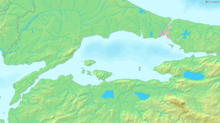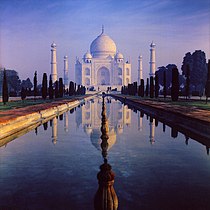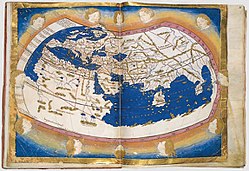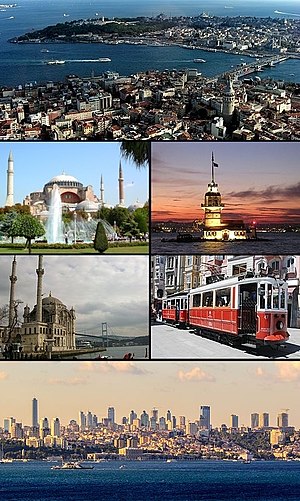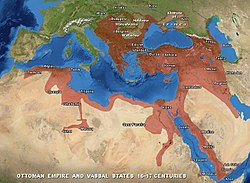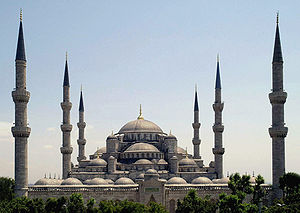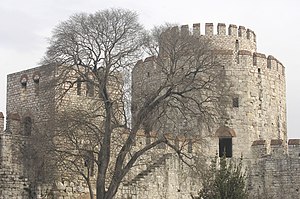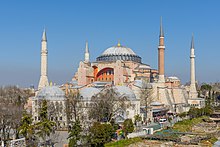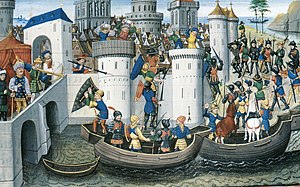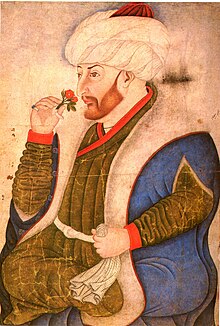“Night had fallen on the ancient Byzantine capital”
The Byzantine were a people of the Byzantine Empire which was initially the eastern half of the Roman Empire, survived the collapse of the Western Roman Empire and continued to thrive and exist for an additional thousand years until if fell to the Ottoman Turks.
“All along the banks of the Sea of Marmara…”
The Sea of Marmara, also known as the Sea of Marmora or the Maramara Sea, is located within the border of Turkey and connects the Black Sea to the Aegean Sea.
“…illuminating a skyline of glistening mosques and slender minarets.”
A minaret is a distinctive architectural feature of mosques, usually a tall spire with an onion-shaped or conical crown. They provide a visual focal point and are used for the call to prayer.
“…the city reverberated with the haunting intonations of the adhān…”
The adhān is the Islamic call to worship, at prescribed times of the day. It is called out from the mosque five times a day, traditionally from the minaret, and summons Muslims tor mandatory worship.
“…this timeless city was quite literally the bridge from the Old World…”
The “Old World” consists of Europe, Asia, and Africa and is known as the part of the world known to the Europeans before Europeans came into contact with the Americas.
“…a world that was even older. Istanbul”
Istanbul is the largest city in Turkey. It is located between the Sea of Marmara and the Black Sea.
“…and the Ottoman.”
The Ottoman Empire, also referred to as the Turkish Empire or Turkey, was a empire founded by Turkish tribes with the conquest of Constatinople.
“From Topkapi Palace….”
Tokapi Palace is a large palace in Istanbul, Turkey. It was the primary residence of the Ottoman Sultans for around 400 years.
“…to the Blue Mosque…”
Also known as the Sultan Ahmed Mosque, the Blue Mosque is located in Istanbul. It was called such for the blue tiles adorning the walls of its interior.
“…to the Castle of the Seven Towers…”
The Castle of Seven Towers, also known as the Yedikule Fortress, is located in the Yedikule neighborhood of Istanbul.
“…on final approach to the Atatϋrk Airport.”
The Atatϋrk Airport is the main international airport in Istanbul.
“The Bosporus appeared as a wide gash…”
Th Bosphorus, also referred to as the Istanbul Strait, forms part of the boundary between Europe and Asia. Together with the Sea of Maramara and the Dardanelles strait, the three form the Turkish Straits.
“…built in A.D. 360, Hagia Sophia had served as an Eastern Orthodox cathedral until 1204….”
Meaning Holy Wisdom, the Hagia Sophia used to be a Greek Orthodox church, then a imperial mosque, and is currently a museum in Istanbul.
“…Enrico Dandolo and the Fourth Crusade…”
The Fourth Crusade (1202-1204) was intended to conquer Muslim-controlled Jerusalem by invading through Egypt. Instead, the Crusaders invaded and sacked Constantinople. This was seen as one of the final acts in the Great Schism between the Eastern Orthodox Church and the Roman Catholic Church.
“…following the conquest of Constantinople…”
Constantinople was the capital city of the Roman, Byzantine, Latin , and Ottoman empires. It was the largest and wealthiest European city in the 12th century. It is modern day Istanbul.
“…by Fatih Sultan Mehmed…”
Also known as Mehmed II or Mehmed the Conqueror, he was twice the Sultan of the Ottoman Empire. At the age of 21, he conquered Constantinople and brought an end to the Byzantine Empire. He is regarded as the national hero in Turkey.
“…documentary film director named Göksel Gϋlensoy.”
Göksel Gϋlensoy tried to reveal the secrets of the Hagia Sophia with his team of two divers and four spelunkers. They dived to learn more about the reservoirs which are connected to Topkapi Palace and Underground Cistern. He started his studies in 1998.
Hϋrriyet Daily News
“…a composite of various news sources including the Hϋrriyet Daily News…”
The Hürriyet Daily News is the oldest English-language daily in Turkey.
“…discussing Gϋlensoy’s newest film: In the Depths of Hagia Sophia”
A documentary meant to reveal the secrets of the Hagia Sophia’s underground.
“…submerged tunnels connecting Hagia Sophia to Topkapi Palace, Tekfur Palace…”
Also known as The Palace of the Porphyrogenitus, Tekfur Palace is Byzantine palace in the north-western part of Istanbul. It is the only Byzantine palace to survive in the old city of Constantinople.
“…and the rumored subterranean extensions of the Anemas Dungeons”
The Anemas Dungeons is a large Byzantine building attached to the walls of Constantinople. It is thought to be named after Michael Anemas, a Byzantine general who, as a result of his unsuccessful uprising, was the first person to be imprisoned. Four Byzantine emperors have also been imprisoned there.
Solublon bag
“If that Solublon bag dissolves before we arrive…”
A solublon bag is what Zobrist chooses to keep his plague in. It is perfect because it has enough durability to last on it’s own, and then dissolve into the water like nothing was there.
“…one with consistent water temperature, no solar radiation…”
Also known as sunlight, here Brown is stating that no sunlight will reach the bag to tamper with it’s contents.
Kinetic buffer
“…a kinetic buffer, and total privacy.”
Here Brown is trying to say that the bag will not be touched or interfered with by other moving objects.
“…an army of WHO employees in hazmat suits.”
A hazmat suit (hazardous materials suit) is a personal protective equipment against hazardous materials. They are mostly used by firefighters, researchers, personnel responding to toxic spills (like in WHO in the Inferno), specialists cleaning up contamination and workers in toxic environments.

